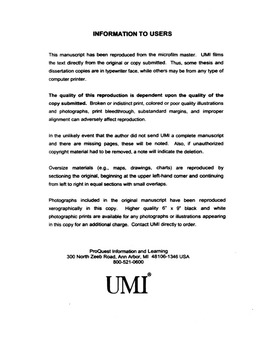| dc.contributor.advisor | Frech, Roger, | en_US |
| dc.contributor.author | Rhodes, Christopher Peter. | en_US |
| dc.date.accessioned | 2013-08-16T12:18:25Z | |
| dc.date.available | 2013-08-16T12:18:25Z | |
| dc.date.issued | 2001 | en_US |
| dc.identifier.uri | https://hdl.handle.net/11244/387 | |
| dc.description.abstract | A symmetry-based vibrational analysis is used to interpret bands in crystalline polymer-salt compounds. Vibrational spectroscopic data of crystalline polymer:salt complexes reveal the presence of dynamic coupling of the triflate anion modes which is characteristic of a highly ordered crystalline matrix. The comparison of x-ray, vibrational spectroscopic, and DSC data of the crystalline and amorphous phases reveals structural similarities and differences between the phases. Analysis of Raman and x-ray data of PEO-LiCF3SO 3 films suggests that the amorphous phase contains local structures which resemble the structure present in crystalline P(EO)3:LiCF 3SO3. It is proposed that within the "amorphous" phase of the polymer-salt systems there exist salt-rich regions whose local structures resemble the crystalline compound. These local structures have implications for ionic transport, since ions at the domain boundaries of salt-rich regions or clusters may make a significant contribution to the ionic conductivity. | en_US |
| dc.description.abstract | The characterization of crystalline phases of polymer-salt complexes and model systems provides particular insight into local structure in these systems. Crystalline phases of systems with the general formula CH3(OCH 2CH2)nOCH3:MX where n = 1--4 and MX = LiCF3SO3, or NaCF3SO3, have been isolated and characterized. The comparison of these structures provides insight into changes in coordination and conformation with chain length. In a number of the crystalline structures, the local coordination environment of the cation and the torsional angle sequences of the bonds in the ethylene oxide units are remarkably similar to those present in the high molecular weight crystalline compounds. The comparison of spectra of the glyme-salt crystalline compounds to glyme-salt solutions shows that both similar and different local structures are present in solution compared to the crystalline phase. | en_US |
| dc.description.abstract | Polymer electrolytes represent a relatively new class of ionic conductors with potential applications in rechargeable batteries and other electrochemical devices. The most investigated systems consist of poly(ethylene oxide), PEO, with dissolved salts. Ionic transport in these systems is highly coupled to the relaxation processes of the polymer backbone and has been determined to occur predominantly in the amorphous phase for a number of polymer-salt systems. The microscopic mechanism of ionic transport in these systems is not well understood, but certainly involves the breaking and reforming of cation-ether oxygen bonds and changes in the local conformation. The characterization of ion-ion and ion-polymer interactions furthers our molecular level understanding of ionic conductivity in these systems. | en_US |
| dc.format.extent | ix, 123 leaves : | en_US |
| dc.subject | Energy. | en_US |
| dc.subject | Cations. | en_US |
| dc.subject | Chemistry, Physical. | en_US |
| dc.subject | Crystalline polymers. | en_US |
| dc.subject | Polyelectrolytes. | en_US |
| dc.title | Crystalline and amorphous phases in polymer electrolytes and model systems. | en_US |
| dc.type | Thesis | en_US |
| dc.thesis.degree | Ph.D. | en_US |
| dc.thesis.degreeDiscipline | Department of Chemistry and Biochemistry | en_US |
| dc.note | Source: Dissertation Abstracts International, Volume: 62-10, Section: B, page: 4567. | en_US |
| dc.note | Major Professor: Roger Frech. | en_US |
| ou.identifier | (UMI)AAI3029614 | en_US |
| ou.group | College of Arts and Sciences::Department of Chemistry and Biochemistry | |
